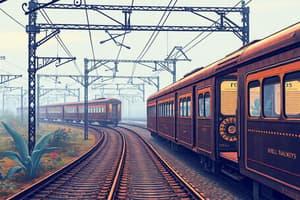Podcast
Questions and Answers
What is the function of insulators in the OHE system?
What is the function of insulators in the OHE system?
- To regulate the temperature of the OHE system
- To insulate the OHE of one track from another (correct)
- To enhance the electrical conductivity of the wires
- To support the weight of the OHE
At what height should the contact wire be maintained over level crossings?
At what height should the contact wire be maintained over level crossings?
- 5.80 M
- 5.75 M
- 5.50 M (correct)
- 4.67 M
What is the purpose of the neutral section (NS) in an OHE system?
What is the purpose of the neutral section (NS) in an OHE system?
- To separate the OHE of two adjoining feed posts (correct)
- To reduce voltage drop across long distances
- To enhance the power transfer to the locomotive
- To connect two traction transformers
How many traction transformers does each traction sub-station (TSS) typically have?
How many traction transformers does each traction sub-station (TSS) typically have?
What is the minimum height requirement for the contact wire over an electric loco shed?
What is the minimum height requirement for the contact wire over an electric loco shed?
What voltage was demonstrated by French National Railways as superior for electric traction in 1955?
What voltage was demonstrated by French National Railways as superior for electric traction in 1955?
In which year did Indian Railways begin adopting the 25 KV system for their electrification scheme?
In which year did Indian Railways begin adopting the 25 KV system for their electrification scheme?
What was the total cumulative electrification reached by the end of the 7th Plan (1990-92)?
What was the total cumulative electrification reached by the end of the 7th Plan (1990-92)?
Which plan had the highest total electrification in terms of RKM (Route Kilometers)?
Which plan had the highest total electrification in terms of RKM (Route Kilometers)?
What was the cumulative electrification at the end of the 1st Plan (1951-56)?
What was the cumulative electrification at the end of the 1st Plan (1951-56)?
Which year was marked by the first electric train from BINA to KATNI?
Which year was marked by the first electric train from BINA to KATNI?
What was the total electrification at the end of the 10th Plan (2002-2007)?
What was the total electrification at the end of the 10th Plan (2002-2007)?
What period corresponds to the 3rd Plan's electrification progress?
What period corresponds to the 3rd Plan's electrification progress?
What percentage of Indian Railways' total track is electrified?
What percentage of Indian Railways' total track is electrified?
How much is the average cost of electrification for double line using 25 KV AC traction?
How much is the average cost of electrification for double line using 25 KV AC traction?
Which of the following RKM values corresponds to total RKM energized on 25 KV AC?
Which of the following RKM values corresponds to total RKM energized on 25 KV AC?
What is the total traction charge in million Rs. for the year 2006-07?
What is the total traction charge in million Rs. for the year 2006-07?
What diameter is the dropper wire used in the Over Head Equipment (OHE)?
What diameter is the dropper wire used in the Over Head Equipment (OHE)?
What is the electrification work in progress as of December 2009?
What is the electrification work in progress as of December 2009?
What is the overall diameter of the Catenary wire?
What is the overall diameter of the Catenary wire?
Which traction type had 49% of passenger train KM hauled?
Which traction type had 49% of passenger train KM hauled?
How much energy was consumed in million KWH during the year 2007-08?
How much energy was consumed in million KWH during the year 2007-08?
Which type of copper is used for the contact wire?
Which type of copper is used for the contact wire?
What is the total current carrying capacity of both wires?
What is the total current carrying capacity of both wires?
What type of wire is used as the Catenary wire in the OHE?
What type of wire is used as the Catenary wire in the OHE?
What is the average cost per KWH for the year 2005-06 expressed in paisa?
What is the average cost per KWH for the year 2005-06 expressed in paisa?
How does the span vary in the OHE system?
How does the span vary in the OHE system?
What is the primary purpose of using an independent mast in the OHE system?
What is the primary purpose of using an independent mast in the OHE system?
Which type of portal is used in multiple track sections where space is limited?
Which type of portal is used in multiple track sections where space is limited?
When is a presag of 100 mm provided on the contact wire?
When is a presag of 100 mm provided on the contact wire?
What is the condemning size of the contact wire?
What is the condemning size of the contact wire?
What is the purpose of galvanizing masts and portals?
What is the purpose of galvanizing masts and portals?
Which of the following is not a type of foundation used for traction masts?
Which of the following is not a type of foundation used for traction masts?
What is the maximum effective distance the contact wire can sweep beyond the center line of the pantograph pan on tangent tracks?
What is the maximum effective distance the contact wire can sweep beyond the center line of the pantograph pan on tangent tracks?
What is the minimum vertical clearance required for long duration conditions under worst cases?
What is the minimum vertical clearance required for long duration conditions under worst cases?
How often are the OHE conductors terminated?
How often are the OHE conductors terminated?
What is the distance maintained between the conductors during an uninsulated overlap?
What is the distance maintained between the conductors during an uninsulated overlap?
What is the purpose of installing an anticreep point in regulated OHE systems?
What is the purpose of installing an anticreep point in regulated OHE systems?
What is the minimum horizontal distance required for short duration conditions?
What is the minimum horizontal distance required for short duration conditions?
Which type of overlap has conductors kept 500 mm apart?
Which type of overlap has conductors kept 500 mm apart?
What is the primary reason for staggering the contact wire at support?
What is the primary reason for staggering the contact wire at support?
What kind of switch is used to bridge electrical continuity at an insulated overlap?
What kind of switch is used to bridge electrical continuity at an insulated overlap?
What is the main concern regarding the physical clearance of conductors at support?
What is the main concern regarding the physical clearance of conductors at support?
What is the minimum contact wire height specified for an electric loco shed?
What is the minimum contact wire height specified for an electric loco shed?
What is the role of the overlap in the runners during a pantograph's transition from one track to another?
What is the role of the overlap in the runners during a pantograph's transition from one track to another?
What is the capacity of each traction transformer in a traction sub-station?
What is the capacity of each traction transformer in a traction sub-station?
Which of the following temperature conditions requires the highest minimum height for the contact wire?
Which of the following temperature conditions requires the highest minimum height for the contact wire?
What function does the Neutral Section (NS) serve in an OHE system?
What function does the Neutral Section (NS) serve in an OHE system?
What was the cumulative electrification achieved during the 4th Plan (1969-74)?
What was the cumulative electrification achieved during the 4th Plan (1969-74)?
Which Plan had the highest amount of electrification in terms of RKM?
Which Plan had the highest amount of electrification in terms of RKM?
In which year did Indian Railways start electrofuelling from BINA to KATNI?
In which year did Indian Railways start electrofuelling from BINA to KATNI?
What was the total electrified RKM by the end of the 6th Plan (1980-85)?
What was the total electrified RKM by the end of the 6th Plan (1980-85)?
Which of the following time periods corresponds to the 2nd Plan's electrification progress?
Which of the following time periods corresponds to the 2nd Plan's electrification progress?
What was the cumulative electrification total reached by the end of the 9th Plan (1997-2002)?
What was the cumulative electrification total reached by the end of the 9th Plan (1997-2002)?
What was the cumulative electrification achieved during the 3rd Plan (1961-66)?
What was the cumulative electrification achieved during the 3rd Plan (1961-66)?
Which year marked the completion of the 1st Plan's electrification progress?
Which year marked the completion of the 1st Plan's electrification progress?
What percentage of Indian Railways' passenger train kilometers are hauled by electric traction?
What percentage of Indian Railways' passenger train kilometers are hauled by electric traction?
What is the total RKM energized on 1500 V DC for Broad Gauge (BG)?
What is the total RKM energized on 1500 V DC for Broad Gauge (BG)?
What is the total cross-sectional area of the Catenary wire?
What is the total cross-sectional area of the Catenary wire?
Which type of portal is used in regions where space for independent masts is limited?
Which type of portal is used in regions where space for independent masts is limited?
What is the approximate average cost of electrification for a double line using 25 KV AC traction?
What is the approximate average cost of electrification for a double line using 25 KV AC traction?
What is the average cost per kilowatt-hour (KWH) for the year 2006-07 expressed in paisa?
What is the average cost per kilowatt-hour (KWH) for the year 2006-07 expressed in paisa?
What is the difference in diameter between the Catenary wire and the contact wire?
What is the difference in diameter between the Catenary wire and the contact wire?
How many types of foundations are commonly used for traction masts?
How many types of foundations are commonly used for traction masts?
What tension is maintained in each conductor of the Over Head Equipment (OHE)?
What tension is maintained in each conductor of the Over Head Equipment (OHE)?
What is the total electrification work in progress as of December 2009?
What is the total electrification work in progress as of December 2009?
What is the presag provided on the contact wire for a maximum span of 72 meters?
What is the presag provided on the contact wire for a maximum span of 72 meters?
What is the total energy consumed in million KWH during the year 2007-08?
What is the total energy consumed in million KWH during the year 2007-08?
What is the maximum wind pressure associated with the adoption of a 72 meter span?
What is the maximum wind pressure associated with the adoption of a 72 meter span?
Which type of steel mast is NOT mentioned in the provided information?
Which type of steel mast is NOT mentioned in the provided information?
Which wire size is used for the contact wire in the overhead equipment?
Which wire size is used for the contact wire in the overhead equipment?
What diameter is the contact wire used in the OHE system?
What diameter is the contact wire used in the OHE system?
What type of traction has 63% of Broad Gauge (BG) freight GTKM hauled?
What type of traction has 63% of Broad Gauge (BG) freight GTKM hauled?
What is the overall conductivity percentage of the Catenary wire?
What is the overall conductivity percentage of the Catenary wire?
What is the total RKM for double line electrification on 25 KV AC?
What is the total RKM for double line electrification on 25 KV AC?
Which foundation type is not considered standard for traction masts?
Which foundation type is not considered standard for traction masts?
What is the maximum distance the contact wire can sweep beyond the center line of the pantograph pan on curved tracks?
What is the maximum distance the contact wire can sweep beyond the center line of the pantograph pan on curved tracks?
During short duration conditions, what is the minimum horizontal clearance required between live parts and fixed structures?
During short duration conditions, what is the minimum horizontal clearance required between live parts and fixed structures?
What is the purpose of the anticreep point installed in regulated OHE systems?
What is the purpose of the anticreep point installed in regulated OHE systems?
What type of overlap has conductors that are separated by 200 mm and interconnected by jumpers?
What type of overlap has conductors that are separated by 200 mm and interconnected by jumpers?
When staggering the contact wire at support, what is the primary objective of allowing it to sweep across the pantograph pan?
When staggering the contact wire at support, what is the primary objective of allowing it to sweep across the pantograph pan?
What is the minimum vertical clearance required under worst conditions for long-duration exposure?
What is the minimum vertical clearance required under worst conditions for long-duration exposure?
How often are the OHE conductors terminated to ensure effective operation?
How often are the OHE conductors terminated to ensure effective operation?
What is the distance maintained between conductors during an insulated overlap?
What is the distance maintained between conductors during an insulated overlap?
What adjustment is made to the height of the conductors at support during the changeover process?
What adjustment is made to the height of the conductors at support during the changeover process?
For electrical continuity at insulated overlaps, which device is typically used?
For electrical continuity at insulated overlaps, which device is typically used?
Flashcards
Electric Traction in India
Electric Traction in India
The use of electricity to power trains in India, starting with a 25 KV single-phase AC system.
25 KV Single Phase AC
25 KV Single Phase AC
A specific electrical system used for train traction in India, found superior to others.
Electrification Progress
Electrification Progress
The gradual increase in the use of electric trains in India over time.
Indian Railways Electrification
Indian Railways Electrification
Signup and view all the flashcards
1957 Electrification Start
1957 Electrification Start
Signup and view all the flashcards
Electrified Track Length
Electrified Track Length
Signup and view all the flashcards
First Electric Train Route
First Electric Train Route
Signup and view all the flashcards
Electrification Plans
Electrification Plans
Signup and view all the flashcards
Indian Railway Track Length
Indian Railway Track Length
Signup and view all the flashcards
Electrified Track Length (2009)
Electrified Track Length (2009)
Signup and view all the flashcards
Electrification Percentage (2009)
Electrification Percentage (2009)
Signup and view all the flashcards
25 KV AC Electrification Cost (per km, single line)
25 KV AC Electrification Cost (per km, single line)
Signup and view all the flashcards
1500 V DC Electrification (km)
1500 V DC Electrification (km)
Signup and view all the flashcards
25 KV AC Electrification (km)
25 KV AC Electrification (km)
Signup and view all the flashcards
2x25 KV AC Electrification (km)
2x25 KV AC Electrification (km)
Signup and view all the flashcards
Electrification Work in Progress (2009)
Electrification Work in Progress (2009)
Signup and view all the flashcards
2009-10 Electrification Target
2009-10 Electrification Target
Signup and view all the flashcards
Electric Passenger Train KMs (2009)
Electric Passenger Train KMs (2009)
Signup and view all the flashcards
Catenary wire composition
Catenary wire composition
Signup and view all the flashcards
Contact wire material
Contact wire material
Signup and view all the flashcards
Current carrying capacity
Current carrying capacity
Signup and view all the flashcards
OHE span range
OHE span range
Signup and view all the flashcards
Span reduction
Span reduction
Signup and view all the flashcards
OHE support mast types
OHE support mast types
Signup and view all the flashcards
Portal use
Portal use
Signup and view all the flashcards
Foundation types
Foundation types
Signup and view all the flashcards
Contact wire presag (sag)
Contact wire presag (sag)
Signup and view all the flashcards
Presag's implication for speed
Presag's implication for speed
Signup and view all the flashcards
Contact Wire Staggering
Contact Wire Staggering
Signup and view all the flashcards
Pantograph Pan Movement
Pantograph Pan Movement
Signup and view all the flashcards
Electrical Clearance
Electrical Clearance
Signup and view all the flashcards
Electrical Clearance: Long Duration
Electrical Clearance: Long Duration
Signup and view all the flashcards
Electrical Clearance: Short Duration
Electrical Clearance: Short Duration
Signup and view all the flashcards
OHE Conductor Termination
OHE Conductor Termination
Signup and view all the flashcards
Conductor Overlap
Conductor Overlap
Signup and view all the flashcards
Uninsulated Overlap
Uninsulated Overlap
Signup and view all the flashcards
Insulated Overlap
Insulated Overlap
Signup and view all the flashcards
Anticreep Point
Anticreep Point
Signup and view all the flashcards
Section Insulator
Section Insulator
Signup and view all the flashcards
Pantograph Overlap
Pantograph Overlap
Signup and view all the flashcards
OHE Contact Wire Height
OHE Contact Wire Height
Signup and view all the flashcards
Traction Sub Station (TSS)
Traction Sub Station (TSS)
Signup and view all the flashcards
Feed Post (FP)
Feed Post (FP)
Signup and view all the flashcards
What system does Indian Railways use for electric traction?
What system does Indian Railways use for electric traction?
Signup and view all the flashcards
Who was the collaborator in Indian Railways initial electrification?
Who was the collaborator in Indian Railways initial electrification?
Signup and view all the flashcards
When did Indian Railways start using electric traction?
When did Indian Railways start using electric traction?
Signup and view all the flashcards
Track Length Electrified (2009)
Track Length Electrified (2009)
Signup and view all the flashcards
What is a Traction Sub Station (TSS)?
What is a Traction Sub Station (TSS)?
Signup and view all the flashcards
What is the purpose of a Feed Post (FP)?
What is the purpose of a Feed Post (FP)?
Signup and view all the flashcards
What is the purpose of the catenary and contact wires?
What is the purpose of the catenary and contact wires?
Signup and view all the flashcards
Electrification Cost per Kilometer
Electrification Cost per Kilometer
Signup and view all the flashcards
What is 2x25 KV AC Electrification?
What is 2x25 KV AC Electrification?
Signup and view all the flashcards
Overhead Equipment (OHE)
Overhead Equipment (OHE)
Signup and view all the flashcards
Catenary Wire
Catenary Wire
Signup and view all the flashcards
Contact Wire
Contact Wire
Signup and view all the flashcards
Automatic Tensioning Device
Automatic Tensioning Device
Signup and view all the flashcards
What is the OHE supported by?
What is the OHE supported by?
Signup and view all the flashcards
What does the TSS connect to?
What does the TSS connect to?
Signup and view all the flashcards
What is the purpose of a section insulator?
What is the purpose of a section insulator?
Signup and view all the flashcards
OHE Span
OHE Span
Signup and view all the flashcards
OHE Mast Types
OHE Mast Types
Signup and view all the flashcards
Contact Wire Presag
Contact Wire Presag
Signup and view all the flashcards
Presag for Speed
Presag for Speed
Signup and view all the flashcards
Contact Wire Height
Contact Wire Height
Signup and view all the flashcards
Long Duration Clearance
Long Duration Clearance
Signup and view all the flashcards
Short Duration Clearance
Short Duration Clearance
Signup and view all the flashcards
Study Notes
Traction Distribution
- French National Railways (SNCF) demonstrated 25 KV single-phase, 50 cycles AC system's superiority in 1955.
- Indian Railways adopted this system in 1957 in collaboration with SNCF.
- Indian Railways are now independently carrying out electrification works.
Plan-Wise Progress of Electrification on IR
- Pre-Independence period (1945-47): 388 RKM electrified.
- Plan 1 (1951-56): 141 RKM electrified, cumulative total 529 RKM.
- Plan 2 (1956-61): 216 RKM electrified, cumulative total 745 RKM.
- Plan 3 (1961-66): 1678 RKM electrified, cumulative total 2423 RKM.
- Plan 4 (1966-69): 814 RKM electrified, cumulative total 3237 RKM.
- Plan 5 (1969-74): 935 RKM electrified, cumulative total 4190 RKM.
- Plan 6 (1974-78): 533 RKM electrified, cumulative total 4723 RKM.
- Plan 7 (1978-80): 195 RKM electrified, cumulative total 4918 RKM.
- From Plan 1 to 11th plan (1980-85, 1985-90, 1990-92, 1992-97, 1997-2002,2002-2007). Electrified RKM data are listed.
- Electrified cumulative RKM up to March 31, 2009: 18942 RKM.
- Total Track electrified up to March 31, 2009: 63327 RKM.
- Percentage of electrified track in India: 29.85%.
- First electric train traveled from Bina to Katni on January 16, 1995.
Cost of Electrification
- Approximate average cost of electrification is provided per kilometer for 25 KV AC and 2x25 KV AC traction and single line and double line.
Details of Electrification
- Details of RKM energized by voltage types (1500 V DC, 25 KV AC, and 2x25 KV AC) are presented.
- Electrification work progress in December 2009.
- Percentage of passenger and freight train kilometers by electrification.
- Data on total traction charges (in millions of rupees) from 2005-06 to 2007-08 and energy consumed (in millions of kWh).
- Average cost per kWh (in paise).
Over Head Equipment (OHE)
- OHE components and their dimensions (e.g., size of Catenary wire, contact wire, dropper wires, conductors).
- Details for Catenary wire, its composition, diameter, cross-sectional area, and current carrying capacity are detailed.
- Contact wire specifications are provided, including size and material.
- OHE span variations, ranging from 72 meters to 27 meters with a 4.5-meter step, are described.
- Maximum span considerations based on wind pressure (112.5 kg/m² and 75 kg/m²).
- Span reduction based on curvature.
- Type and Material used for mast, portals, and foundations used.
- Methods of maintaining electrical clearance between live and earthed parts.
- Minimum vertical distances and minimum horizontal distances in different scenarios (long duration, short duration).
- Details of OHE conductors termination, overlapping methods (uninsulated, insulated), jumpers, and connection methods are detailed (e.g., 200 mm distance in uninsulated overlaps, 500 mm in insulated overlaps).
Traction Substation (TSS)
- Each TSS has two traction transformers, one working and one as standby.
- Capacity of each transformer is sufficient for its own and half of the adjacent feed zone.
- Feeding Post (FP) is responsible for supplying 25KV traction power to OHE.
- Feed length is described as the traction transformer zone.
Other Types of OHE
- Neutral section (NS), sectionalization
- Sectioning post (SP), sub-sectioning
- Sector and Sub-sector
- Elementary Section (ES)
Studying That Suits You
Use AI to generate personalized quizzes and flashcards to suit your learning preferences.




